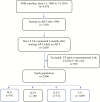Persistent Low-level Viremia While on Antiretroviral Therapy Is an Independent Risk Factor for Virologic Failure
- PMID: 30785191
- PMCID: PMC6880328
- DOI: 10.1093/cid/ciz129
Persistent Low-level Viremia While on Antiretroviral Therapy Is an Independent Risk Factor for Virologic Failure
Abstract
Background: Whether persistent low-level viremia (pLLV) predicts virologic failure (VF) is unclear. We used data from the US Military HIV Natural History Study (NHS), to examine the association of pLLV and VF.
Methods: NHS subjects who initiated combination antiretroviral therapy (ART) after 1996 were included if they had 2 or more VLs measured with a lower limit of detection of ≤50 copies/mL. VF was defined as a confirmed VL ≥200 copies/mL or any VL >1000 copies/mL. Participants were categorized into mutually exclusive virologic categories: intermittent LLV (iLLV) (VL of 50-199 copies/mL on <25% of measurements), pLLV (VL of 50-199 copies/mL on ≥25% of measurements), high-level viremia (hLV) (VL of 200-1000 copies/mL), and continuous suppression (all VL <50 copies/mL). Cox proportional hazards models were used to evaluate the association between VF and LLV; hazard ratios and 95% confidence interval (CI) are presented.
Results: Two thousand six subjects (median age 29.2 years, 93% male, 41% black) were included; 383 subjects (19%) experienced VF. After adjusting for demographics, VL, CD4 counts, ART regimen, prior use of mono or dual antiretrovirals, and time to ART start, pLLV (3.46 [2.42-4.93]), and hLV (2.29 [1.78-2.96]) were associated with VF. Other factors associated with VF include black ethnicity (1.33 [1.06-1.68]) and antiretroviral use prior to ART (1.79 [1.34-2.38]). Older age at ART initiation (0.71 [0.61-0.82]) and non-nucleoside reverse transcriptase inhibitor (0.68 [0.51-0.90]) or integrase strand transfer inhibitor use (0.26 [0.13-0.53]) were protective.
Conclusion: Our data add to the body of evidence that suggests persistent LLV is associated with deleterious virologic consequences.
Keywords: HIV; persistent low-level viremia; virologic failure.
© The Author(s) 2019. Published by Oxford University Press for the Infectious Diseases Society of America. All rights reserved. For permissions, e-mail: journals.permissions@oup.com.
Figures
References
-
- European AIDS Clinical Society. European AIDS clinical society guidelines 2017; Version 9.0 October 2017. Available at: http://www.eacsociety.org/files/guidelines_9.0-english.pdf. Accessed 10 September 2018.
-
- Panel on Antiretroviral Guidelines for Adults and Adolescents. Guidelines for the use of antiretroviral agents in adults and adolescents living with HIV. Department of Health and Human Services, 2018:H1–H9.1. Available at: https://aidsinfo.nih.gov/guidelines. Accessed 10 September 2018.
-
- World Health Organization. Consolidated strategic information guidelines for HIV in the health sector. 2015. Consolidated guidelines on the use of antiretroviral drugs for treating and preventing hiv infection 2016 recommendations for a public health approach second edition. Available at: https://apps.who.int/iris/bitstream/10665/208825/1/9789241549684_eng.pdf Accessed 4 March 2019.
-
- Havlir DV, Bassett R, Levitan D, et al. . Prevalence and predictive value of intermittent viremia with combination HIV therapy. JAMA 2001; 286:171–9. - PubMed
Publication types
MeSH terms
Substances
LinkOut - more resources
Full Text Sources
Other Literature Sources
Medical
Research Materials


